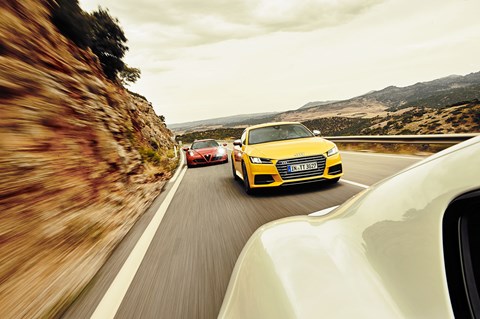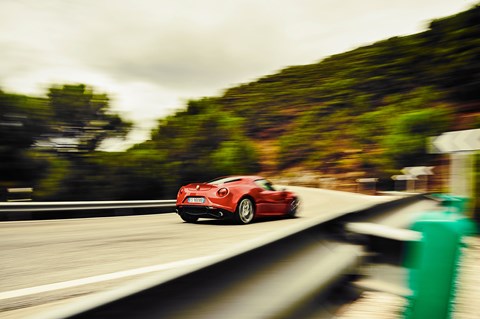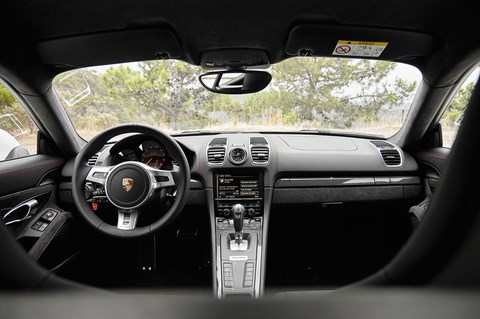► Clash of the £40k-50k super-coupes
► CAR magazine triple test
► 4C, Cayman GTS and TT fight it out
A quiet mountain road curling up from the Mediterranean and away from the madness of Marbella is the venue for this enticing bout, and the challenger, the lurid colour of a minion, is the new Audi TTS. Here to give it a hard time is Porsche’s latest Cayman, the GTS, and a delectable Italian that’s utterly focused on the purity of driving, the carbonfibre Alfa Romeo 4C.
A tough test for the TTS? You bet, but it’s a measure of the regard in which we hold this third-generation Audi icon that we’re not down on the seafront with some flabby coupe-cabrios like the BMW Z4 and Mercedes SLK, but rather up here in the peaks with a pair of proper sports cars. And this might oversimplify the synergies between members of the VW Group, but as the TTS and Golf R effectively share the same turbo engine, twin-clutch gearbox, four-wheel drive system and (acronym fans rejoice!) MQB platform, with the latter the greatest hot hatch on sale right now, just squeezing its oily bits into the tighter confines of a coupe’s corset-like body should de facto create a contender.
The TT isn’t merely a Golf in drag either: some of the core chassis might be steel, but much of it is aluminium, as are nearly all the panels that form the curvaceous and sharply creased exterior. Inside it’s a world away from any people’s car, justifying its £8k premium over the Volkswagen hatchback with an exquisite cabin, complete with a 12.3in TFT display that’s a one-stop shop for all your speedo, sat-nav, and multimedia needs. All in, or at least before you succumb to the extensive options list, it’s £40,270.
Porsche Cayman vs Audi TT vs Alfa Romeo 4C
Can the Cayman GTS justify its preposterous £18k premium? Somehow it must, because if you want a Porsche with power and torque parity to the TTS, one that won’t be found wanting in a game of Top Trumps or, more likely, over discussions at the club after a round of squash, you need to spend the thick end of 60 grand. Which is mad money for a Porsche that’s not a 911.
Especially when you can get a miniature supercar for less. Aficionados will know the £45k 4C has a carbon chassis (otherwise the reserve of the McLaren 650S, Lamborghini Aventador, and a few million-pound hypercars) with a mid-engined layout like the Cayman, enthusiasts will yearn to own it, and if you’re superficial enough to only be interested in the TT because of its looks, then the voluptuous 33 Stradale-aping curves will win you over. Only serious sorts need apply though, as the back-to-basics philosophy of this sub-1000kg flyweight means the steering is unassisted and the cabin is barren, with cup holders, carpets and cruise control all extra. To the TTS…
… which takes a little while to reveal its talents. At first I’m left wondering whether I was expecting too much, whether it’s no better than its Golf R brethren. Yet actually, it’s because the VW is so good that you have to hunt harder to discover where the TTS tops it; 10bhp more makes no difference, but with a lower centre of gravity and 65 fewer kilos to brake, turn and accelerate, its reactions are sharper and more instant.

And even if the TTS is a little hard to distinguish from that VW, it’s significantly distinct from the TTS of yore. That felt like a Golf too, but not a very good one, with clods of understeer and a clumsy four-wheel-drive system. Now the understeer is all but banished unless you’re an idiot, and when you apply the power, there’s not a p-a-u-s-e as the Haldex system detects slip at the front wheels, ponders the possibilities, and then sends power rearwards. Instead it’s instant, and actually preemptive, because with the Drive Select system set to Dynamic, the TTS sends a portion of torque to the rear axle when you chuck it into a bend – or in Audi speak, when ‘the driver turns sportily into a corner’.
How does the new TT drive?
The TTS is much keener to turn as a result, with a more neutral stance through the bends, and then it eggs you on to apply power sooner and sooner. In its predecessor you’d be washing wide, missing the apex and heading for oncoming traffic, but now trick electronics step in, the faux-torque vectoring nibbling at the inside wheels with the brakes, directing the excess torque to the opposite wheels, so the TTS trims its line and carries big corner speeds. Most of the time it’s too subtle to even notice, but just occasionally the rear suddenly feels rather agile, rotating ever so slightly to tighten your trajectory.
What is subtle are the differences between the Drive Select modes. There’s an Efficiency mode to save fuel, but not buying a TTS in the first place will have the same result, so we can ignore that. Instead you’re left with Comfort, Auto, Dynamic and Individual. You’re best leaving the TTS in Dynamic as then the exhaust burbles but isn’t intrusive, the S-tronic gearbox shifts sharply and smoothly, the ride remains controlled and composed, and although it’s not anything approaching real feel, there’s less assistance for the steering, which adds a little heft, and at least gives the illusion of forces building at the front tyres.
It’s not perfect though, not a flawless sports car: the paddles are too small and plastic and really need to be the metal-trimmed items from the S3, or the aluminium fish hooks out of the R8, and ultimately you’re a tad too far removed from all the action, the steering not instant enough, the engine not loud enough, the throttle response not immediate enough.
Of course, how any TT drives is only half the story, and you might well be won over before you’ve even left the Audi showroom. The quality of the plastics and aluminium trim is superior to an A8 limo, the air-con controls are ingeniously integrated into the air vents, and the ‘Virtual Cockpit’ digital dashboard aggregates nearly everything into its hi-res display, which can be a sat-nav screen with stunning images of Google Earth, a traditional pair of dials or, for the TTS only, a massive rev counter right in your face. As interiors go, it’s spectacular.
Alfa Romeo 4C on the road
The 4C feels woeful in comparison. The cabin is sparse and bare, with a pouch for a glovebox, no adjustment for the passenger seat, and the intimidating aura of a proper road-racer – I can’t think of a more extreme, raw or single-minded car on sale today, Ferrari 458 Speciale and its kin included. And while the 458 Speciale feels like it’s been expensively and meticulously pared back, in the Alfa ‘lightweight’ is interchangeable with ‘cheap’ as the naked weave of the carbon chassis sits cheek-by-jowl with hard and nasty plastics, and if you reach behind the air-con controls there’s no cowling, just a tangle of loose wires.
Not that any of this is at the forefront of your mind when you first climb in over the wide carbonfibre sill. You sit low, on cool ribbed seats, far forward and out in the nose like you do in a 458 or McLaren 650S, the front wings rising up ahead to frame the road, your door mirrors filled with the evocative haunches and deep air intakes, and all you can see in the rear-view mirror is the top of an engine that’s butting right up against the bulkhead behind you. It feels intimidating, every inch a proper old-school supercar.
Then the turbo’d four-pot engine bangs into life and sets you further on edge. Your ears are bombarded with a cacophony of noises, the intakes sucking and roaring, the engine thrashing and growling, the turbo and its associated pipework hissing and exhaling, the exhaust throbbing and burbling as the 4C channels the spirit of an angry Group B racer. It’s overwhelming, every flex of your right foot changing the pitch and tone and temperament of the sounds that envelop you; you’ve actually got to block them out before you can concentrate on the rest of the 4C.

Do that, and then you pick up the steering jinking and darting in your hands as it follows bumps and camber, recognise that the throttle response is sharper and the kick in the back more instant and severe than the TTS, that the brake pedal is firm underfoot with little travel but huge stopping power, and that this is the only one of our trio whose dual-clutch gearbox doesn’t automatically upshift at the redline. It’s an utterly immersive experience, and if the TTS is all about unadulterated speed, the 4C lets you revel in the rich sensations of driving. It’s like an Italian Elise.
You can’t be apathetic towards it, any drive is too involving for that, and thus the emotions it creates are intense – and that means you’ll hate it as strongly as you love it. The unassisted steering never quite translates and telegraphs the real feel that the Lotus will, never 100% informs you of where the ultimate grip levels are. The ride, on our car’s optional racing suspension, is busy, and whereas an Elise would trickle at low speeds and then flow as the pace climbs, the 4C too often interrupts itself and can’t build a harmonious rhythm. The gearbox doesn’t shift quickly enough either, the revs rising before each new ratio is engaged, the seats lack lateral support, and steering wheel is terrible, with fat spokes, nothing to hook your fingers into, and tiny plastic paddles that are no more interactive than buttons.
And the Porsche Cayman GTS
That doesn’t mean the Cayman GTS has it all its own way in comparison. After spending a decent chunk of last month racking up miles in a 911 GT3, I know this particular Porsche’s electric steering has some feel in reserve, with a few extra layers separating driver from road – and whatever faults we can pin on the Alfa’s helm, with no electric motor to interfere, it is purer and more nuanced compared with the Cayman. The 911 GT3’s paddleshifters also elicit a more immediate response (they have 50% less travel than other Porsches) so the Cayman’s seem sloppy in comparison. And the naturally aspirated flat-six, with a paltry 14bhp and 7lb ft more than the Cayman S, really needs to be revved – especially when the TTS and 4C are so potent from barely above idle – to keep pace with the opposition.
It’s worth it though, so worth it: second is strong, and third is mega, a long gear that goes on and on, the crisp flat-six howling harder, wailing higher to a proper crescendo. The Cayman sets a big red rev counter – reading to 9000rpm, redlined somewhere around 7500rpm – out in front of you to watch that needle wind out round the clock to its heady highs. Long live naturally aspirated engines, especially when they’re this damn good!
The Porsche scores on the tactility and precision of its controls too, not just the quality of the interior’s buttons and dials, but the steering, throttle and brakes, which in turn translates to an accuracy and exactness on the road. It’s cohesive and balanced where the 4C starts to fall apart on tarmac that does its best to turn a chassis inside out, and it forgives and flatters your indiscretions, whether you’re braking late into a corner or applying the throttle mid-corner. You just can’t be clumsy in the Cayman.

Although it only possesses a 10kg weight advantage over the TTS, it’s where that weight is that counts: there’s no engine hanging out front, instead it’s buried between the axles, down low behind you to keep the rear wheels keyed into the surface, to provide great traction out of corners. The no-cost ‘Sports’ chassis, with stiffer fixed-rate dampers and a 20mm ride-height drop (PASM adjustable dampers, together with 20in wheels, are standard on the GTS) is firm but doesn’t falter on the smooth Spanish tarmac, and the upshot is that the Cayman feels stable and stays flat when you tip it into corners at speed. This side of that GT3, I don’t think there’s a better Porsche around.
Verdict
Where does that leave our trio? You’ll find most fault with the 4C, whether it’s the poor cabin quality, rough ride, low nose that’s constantly getting scuffed, or the tiny boot that’ll bake or melt anything it carries. That, and with those ugly exposed headlights it looks like a spider. With an eye infection. Yet even the Cayman GTS won’t involve and envelope you in the driving experience like the 4C, and if you can live with its foibles, you’ll love it.
The Cayman GTS feels so polished in comparison, but never boring either, its engine and chassis so special. The extra £7k Porsche charges over and above a Cayman S is substantial, especially in this company, but it’s now superior to a 911 Carrera, and there aren’t many cars – at any price – you can say that about.
And the TTS? The best compromise, which isn’t damning it with faint praise. It can’t deliver the all-consuming drive of the 4C, or the dynamic polish and sparkle of the Porsche, but those are extremes of the spectrum. The TTS is fast, fun, home to one of the best interiors on the planet, and in this company, a bit of a bargain too.
What’s more – and credit to the TT here – it feels like it’s got more to give, that the chassis can handle more power. A good job, because if you lift the bonnet, there’s obvious space for a fifth cylinder, and we hear a TT RS is waiting in the wings with enough power not just to take on a Cayman, or even a Carrera, but the 911 Turbo. Third time around, the Audi TT has come of age.
To read more great features like this, buy CAR magazine every month. Click here for a preview and our best subscription offers.